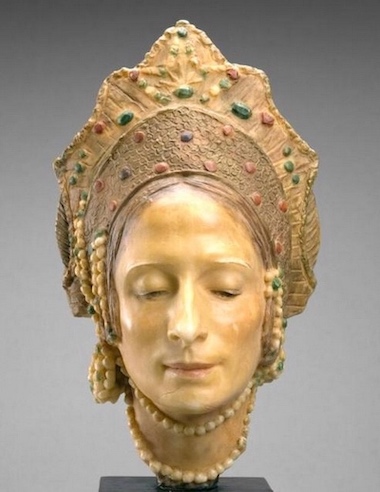
|
|
|
|
|
| Issue 18: | 29 Apr. 2023 |
| Prose Poem: | 99 words |
| + Visual Art: | Sculpture |
Suitcase Full of Clay:
An Ekphrastic eCollection
By Daryl Scroggins
[8] At the Center
—After Malvina Cornell Hoffman’s Mask of Anna Pavlova
Of pivotal importance: head position if balance is to hold. She watches for it even in remembered motions. That stillness of one place, not to be disconcerted even in a house of mirrors. Serenity a gown masking the body’s little rebellions. And age in the wings, waiting to prompt the question one day of why the brain’s command has been delayed. Beneath this face, the motor of a floating swan’s motion—unseen. Remains to be seen. That particular articulated ash, released, would find the beams of every house.

Mask of Anna Pavlova (1924)
Sculpture: wax on plaster with pigment
(The Museum of Fine Arts, Houston)
Publisher’s Notes:
Links below were retrieved on 14 April 2023.
1. For a condensed bio of the artist, see AWARE (Archives of Women Artists, Research and Exhibitions):
https://awarewomenartists.com/en/artiste/malvina-hoffman/
2. Malvina Cornell Hoffman (1885-1966) was an American sculptor and author, known for her life-size bronze sculptures. In 1910, while studying under Rodin in Paris, she saw the Russian ballerina Anna Pavlova in performance. In 1912, Hoffman’s Russian Dancers, depicting Pavlova and Mikhail Mordkin dancing the Bacchanale, won first prize in the Paris Salon. The two women met two years later and soon became close friends. Pavlova modeled dance poses for Hoffman, who was working on a 26-panel frieze of the Bacchanale, which took ten years to complete.
In the meantime, in 1919, Hoffman’s larger-than-life bronze sculpture Russian Bacchanale, featuring Pavlova and Mordkin, became the first work by a woman ever to be installed in the Paris Luxembourg Gardens. (Apparently stolen by the Nazis in 1941, the sculpture was never recovered, although a replica stands on the East Terrace of The Cleveland Museum of Art.)
Mask of Anna Pavlova was first created as a plaster bust and then finished in wax and pigment. The sculpture memorializes the dancer’s costume at a lavish party which was hosted by Hoffman for 200 guests at her studio in May 1924, to celebrate the completion of the Bacchanale frieze. Pavlova appeared as a Byzantine Madonna wearing a bejeweled headdress.
After Pavlova’s unexpected death from pleurisy in 1931, Hoffman was bereft and kept the Bacchanale frieze in her Paris studio for the remainder of her life, 35 years. It was exhibited only once, in 1937 in a Richmond, Virginia museum. After Hoffman’s death, the frieze was gifted by her estate to the Cedar Rapids Museum of Art in Iowa.
Sources include:
Modern Art and Modern Movement: Images of Dance in American Art, c. 1900-1950 by JoLee Gillespie Stephens (Ph.D. of Philosophy, University of Kansas, 2011), which includes material sourced from Malvina Hoffman’s memoir, Yesterday Is Tomorrow: A Personal History (New York: Crown Publishers, 1965); and
Inspired by Pavlova: Malvina Hoffman’s Bacchanale frieze by Didi Hoffman in Dance International (15 January 2022).
Daryl Scroggins
has taught creative writing and literature at The University of Texas at Dallas, The University of North Texas, and the Writer’s Garret, in Dallas. He now lives in Marfa, Texas. He is the author of This Is Not the Way We Came In, a collection of flash fiction and a flash novel (Ravenna Press), Winter Investments: Stories (Trilobite Press), and Prairie Shapes: A Flash Novel (winner of the 2004 Robert J. DeMott Prose Contest). His poems, short stories, and creative nonfictions have appeared in magazines and anthologies across the country, including Blink Ink, Cutbank, Eastern Iowa Review, New Flash Fiction Review, Star 82 Review, and Third Wednesday, among others.
| Copyright © 2019-2025 by MacQueen’s Quinterly and by those whose works appear here. | |
| Logo and website designed and built by Clare MacQueen; copyrighted © 2019-2025. | |
|
Data collection, storage, assimilation, or interpretation of this publication, in whole or in part, for the purpose of AI training are expressly forbidden, no exceptions. |
At MacQ, we take your privacy seriously. We do not collect, sell, rent, or exchange your name and email address, or any other information about you, to third parties for marketing purposes. When you contact us, we will use your name and email address only in order to respond to your questions, comments, etc.